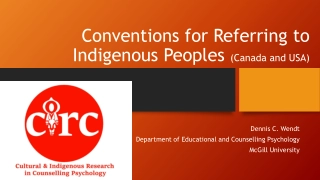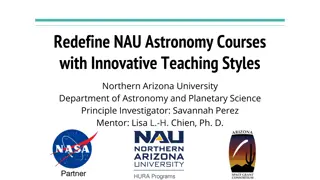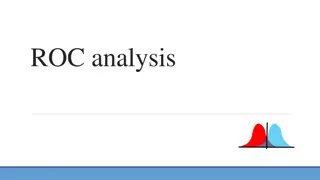Overview of AUC's Indigenous Consultation Framework
The document provides insights into the Alberta Utilities Commission (AUC) role in Indigenous consultation, highlighting the statutory basis and responsibilities in the consultation process. It references legal precedents and court decisions guiding the AUC's engagement with constitutionally-protected Aboriginal rights. The common law principles discussed shed light on the duties and powers delegated to tribunals in determining adequate consultation with Indigenous communities.
Download Presentation

Please find below an Image/Link to download the presentation.
The content on the website is provided AS IS for your information and personal use only. It may not be sold, licensed, or shared on other websites without obtaining consent from the author.If you encounter any issues during the download, it is possible that the publisher has removed the file from their server.
You are allowed to download the files provided on this website for personal or commercial use, subject to the condition that they are used lawfully. All files are the property of their respective owners.
The content on the website is provided AS IS for your information and personal use only. It may not be sold, licensed, or shared on other websites without obtaining consent from the author.
E N D
Presentation Transcript
The AUCs Indigenous Consultation Framework June 2020 Gary Perkins, Counsel
Overview AUC s role in consultation AUC s Indigenous consultation framework AUC s application review process and public participation opportunities
AUCs role in consultation The AUC is not the Crown and is not an agent of the Crown. Nothing in the AUC s core legislation provides express direction about constitutionally-protected Aboriginal rights or the Crown s duty to consult. The AUC s role in consultation is shaped by the powers granted to it by statute and court decisions on the responsibilities independent tribunals have in relation to the duty to consult. 3
Common law guidance s. 35 rights Paul v. British Columbia (Forest Appeals Commission), 2003 SCC 55; Nova Scotia (Workers' Compensation Board) v. Martin, 2003 SCC 54. Paul decision: there is no principled basis for distinguishing s. 35 rights from other constitutional questions. [para 38] The essential question is whether the empowering legislation implicitly or explicitly grants to the tribunal the jurisdiction to interpret or decide any question of law. If it does, the tribunal will be presumed to have the concomitant jurisdiction to interpret or decide that question in light of s. 35 or any other relevant constitutional provision. [para 39] Alberta's Energy and Utilities Board and the Constitution of Canada, Nickie Vlavianos, (2005) 43 Alta. L. Rev. 369 381. 4
Common law guidance - DTC Rio Tinto Alcan Inc. v. Carrier Sekani Tribal Council, 2010 SCC 43: [56] The legislature may choose to delegate to a tribunal the Crown s duty to consult. [57] Alternatively, the legislature may choose to confine a tribunal s power to determinations of whether adequate consultation has taken place, as a condition of its statutory decision-making process. [58] Tribunals considering resource issues touching on Aboriginal interests may have neither of these duties, one of these duties, or both depending on what responsibilities the legislature has conferred on them. Both the powers of the tribunal to consider questions of law and the remedial powers granted it by the legislature are relevant considerations in determining the contours of that tribunal s jurisdiction: Conway. 5
Common law guidance Crown conduct from Haida: the duty arises when the Crown has knowledge, real or constructive, of the potential existence of an Aboriginal right or title and contemplates conduct that might adversely affect it. Standing Buffalo Dakota First Nation v. Enbridge Pipelines Inc., 2009 FCA 308: [40] . The [NEB] process focuses on the applicant, on whom the NEB imposes broad consultation obligation. The applicant must consult with Aboriginal groups, determine their concerns and attempt to address them, failing which the NEB can impose accommodative requirements. , in ensuring that the applicant respects such Aboriginal rights, in my view, the NEB demonstrates that it is exercising its decision-making function in accordance with the dictates of subsection 35(1) of the Constitution. 6
Common law guidance the distinction falls away Clyde River (Hamlet) v. Petroleum Geo-Services Inc., 2017 SCC 40; Chippewas of the Thames First Nation v. Enbridge Pipelines Inc., 2017 SCC 41. From Clyde River: [29] Put plainly, once it is accepted that a regulatory agency exists to exercise executive power as authorized by legislatures, any distinction between its actions and Crown action quickly falls away. It therefore does not matter whether the final decision maker on a resource project is Cabinet or the NEB. In either case, the decision constitutes Crown action that may trigger the duty to consult. [39] . If the Crown s duty to consult has been triggered, a decision maker may only proceed to approve a project if Crown consultation is adequate. ... the key question is whether the duty is fulfilled prior to project approval (Haida, at para. 67) 7
Alberta relies on the AUCs process Letter from the Alberta Minister of Energy to the AUC s Chair, December 2018: Recent Supreme Court of Canada cases have made clear that decisions of independent regulatory tribunals such as the AUC may trigger the Crown s constitutional duty to consult. It has also made clear that the Crown may rely on these tribunals to assess and fulfil that duty. . Where consultation is triggered before these tribunals, Alberta relies on the tribunal's process to address potential impacts to Aboriginal and treaty rights stemming from projects under the tribunal s mandate. 8
Overview of AUCs Indigenous consultation framework initiative The AUC has the authority to consider and address potential adverse impacts to Aboriginal and treaty rights as set out in Section 35 of theConstitution Act, 1982, when deciding whether approval of a utility project is in the public interest. The AUC is updating its application processes and procedures to clarify Indigenous consultation requirements (i.e., Rule 007 and Rule 020). This will help improve the consistency and predictability of decision-making and ensure that potentially affected rights holders have an opportunity to learn about proposed development and make any concerns they have known to the Commission. The goal is to have updated processes and procedures for Indigenous consultation by the fall of 2020. 9
Indigenous consultation framework - goals Issue: clarity is needed on when Indigenous consultation is required in order to understand potential impacts to Aboriginal and treaty rights as provided in Section 35 of the Constitution Act, 1982. The framework will address: the types of utility applications that may trigger the duty to consult, when Indigenous groups should be included in the applicant s participant involvement program, and when notice of a utility application should be provided directly to Indigenous groups, and by whom. 10
Project overview June 2019 -Announced plan to update AUC Rule 007, including updating the application requirements for Indigenous consultation (Bulletin 2019-10). December 2019 -Announced interim direction for applicants and pilot of a new statement of intent to participate for Indigenous groups (Bulletin 2019-20). May 28, 2020 External engagement: draft Indigenous consultation framework published with comments on the draft framework due by July 10, 2020 (Bulletin 2020-22). Summer 2020 Draft edits to Rules 007 and 020 and another round of engagement. Fall 2020 Updates to Rules 007 and 020. 11
Current state pre-application public engagement Participant involvement program (AUC Rule 007) Applicants are responsible for developing a PIP that includes Indigenous groups when there is a potential to impact Section 35 rights. Ideally, the PIP will ensure that Indigenous groups learn about the project early in the process, well before an application is filed with the AUC. Issue for the framework to address: An applicant may not be aware that members of an Indigenous group are practicing Section 35 rights in the area and could be potentially affected. The AUC is developing guidance for when notification should be provided to Indigenous groups by the applicant or the AUC. 12
Expectations of applicants/proponents Effective communication is paramount so that concerns may be raised, properly addressed, and if possible, resolved. Notification -use the official consultation contact(s) and by the method identified on theACO website. Comprehensive project-specific information must be made available (Appendix A1 of Rule 007 and Section 2.3 of Rule 020). Notified a minimum of 14 calendar days prior to filing a utility application. The Commission encourages an applicant to be sensitive to the timing constraints and capacity challenges of Indigenous groups when developing and implementing its participant involvement program. The applicant mustkeep a log containing information on the dates notification occurred or was attempted, whether project information was provided, and to whom the project information was given, as well as any follow-up discussions, including mitigation and commitments. 13
Current state giving notice AUC notice of application The AUC reviews applications on a case-by-case basis to assess if the duty to consult may be triggered by the AUC s decision. Considerations include: Is there potential to impact Section 35 rights (i.e., hunting, fishing, trapping and traditional uses)? what is the scope, scale, duration, magnitude and location of the impact? is the environment affected (air, water, land) is there reliable information that members of an Indigenous group have enjoyed historical and contemporary access to the project area or an area affected by the project? If so, will that access be affected (curtailed or broadened)? 14
Transition state -interim Indigenous consultation and information requirements for proponents All facility applications filed on or after March 1, 2020 must provide: Information on Crown consultation for related regulatory approvals (i.e., PLA, WA, EPEA, HRA). If consultation advice from the Alberta government was not sought by the applicant, the applicant must summarize the steps it took to identify and consult with Indigenous groups. Applicants are encouraged to use the Alberta government s Landscape Analysis Indigenous Relations Tool (LAIRT) to inform their decisions about consultation. If no steps were undertaken to identify and consult with Indigenous groups, the applicant must provide an explanation for that decision. If consultation with Indigenous groups was undertaken, the applicant must provide a summary of that as part of the participant involvement program. 15
Indigenous statement of intent to participate form pilot Recognizes the importance of rights provided in Section 35 of the Constitution Act, 1982. Should help Indigenous groups provide the necessary information to demonstrate to the Commission how the rights being asserted may be directly and adversely affected by a proceeding. The AUC is piloting the use of the form and is seeking feedback from applicants and Indigenous groups on the format and its effectiveness. 16
Future state the draft framework The Commission issued Bulletin 2020-22 on May 28, 2020, which announced the publication of the draft framework on the AUC s website and a public comment period. The Commission will consider all feedback before making revisions to the draft framework. A key piece of the framework is the consultation categories. 17
Draft Indigenous consultation categories Indigenous consultation category Consultation Category A Description AUC notification requirements Crown has determined there is a duty to consult for related approvals. Indigenous groups identified by the Crown must be included in the PIP and given a copy of the NOA. AND/ OR An Indian reserve or Metis Settlement is within the consultation areas (Rule 007 and Rule 020 radii). Indigenous groups with lands in the consultation area must be included in the PIP and given a copy of the NOA. No direct notice to Indigenous groups is required. Applications for new projects or alterations that are: Small (e.g., power plants <10 MW). On private land with limited to no off-site impacts (e.g., transmission lines, solar, wind). In transportation and utility corridors. Letters of enquiry. Consultation Category B Applications for new projects or amendments not captured by categories A and B. Reviewed on a case-by-case basis to determine whether direct notice to Indigenous groups is required. Consultation Category C 18
Next steps Review feedback on draft Indigenous consultation framework (post-July 10, 2020). Possible further round of engagement on the draft framework. Draft updates to Rule 007 and 020. Finalize the framework. Finalize updates to Rules 007 and 020. 19
Indigenous engagement web pages Designed to help Indigenous groups understand the regulatory process and how they can get involved. It also includes guidance on Indigenous consultation for proponents. 20
AUC has experience considering impacts on rights The AUC s standing test is rights-based: AUC Act: 9(2) If it appears to the Commission that its decision or order on an application may directly and adversely affect the rights of a person, the Commission shall (a) give notice of the application in accordance with the Commission rules, (b) give the person a reasonable opportunity of learning the facts bearing on the presented to the Commission by the applicant (c) hold a hearing. application as and other parties to the application, and Dene Tha First Nation v. Alberta (Energy and Utilities Board), 2005 ABCA 68: that provision has two branches. First is a legal test, and second is a factual one. The legal test asks whether the claim right or interest being asserted by the person is one known to the law . Obviously a constitutional, a legal, or an equitable interest would suffice. 21























